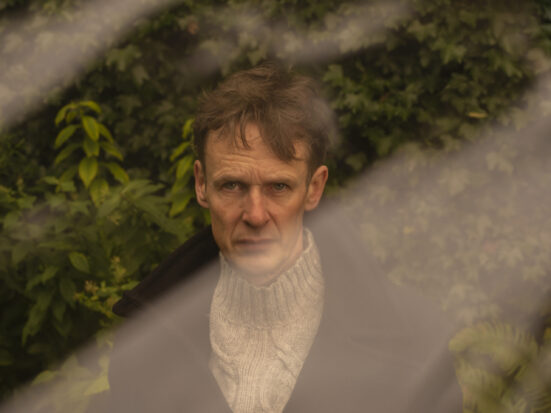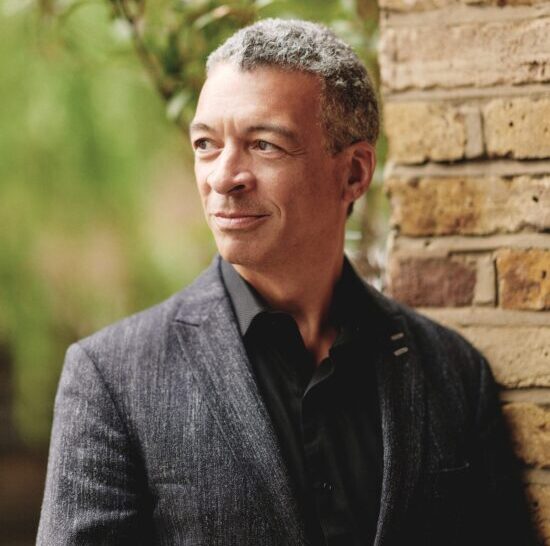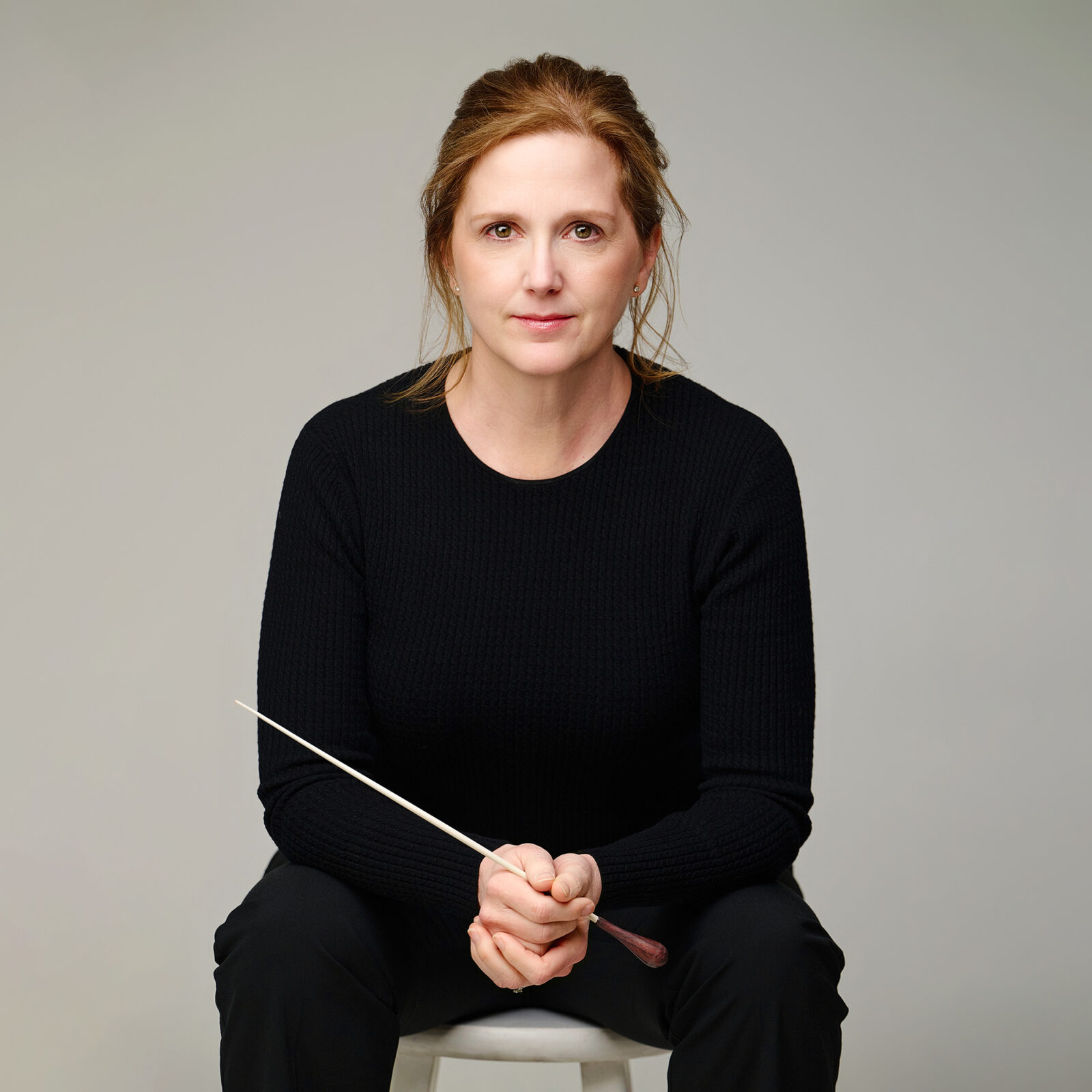Britten’s War Requiem (November 7 & 9, 2025)
Program
November 7 and 9, 2025
- Stéphane Denève, conductor
- Felicia Moore, soprano
- Ian Bostridge, tenor
- Roderick Williams, baritone
- St. Louis Symphony Chorus
- Erin Freeman, director
- The St. Louis Children’s Choirs Concert Choir
- Alyson Moore, artistic director
Benjamin Britten (1913-1976)
- War Requiem, Op. 66
- Words from the Missa pro defunctis and the poems of Wilfred Owen
- Requiem æternam
- What passing-bells for these who die as cattle?
- Dies iræ
- Bugles sang, saddening the evening air
- Out there, we’ve walked quite friendly up
- to Death
- Be slowly lifted up, thou long black arm
- Move him into the sun
- Offertorium
- So Abram rose, and clave the wood
- Sanctus
- After the blast of lightning from the East
- Agnus Dei
- One ever hangs where shelled roads part
- Libera me
- It seems that out of battle I escaped
Felicia Moore, soprano
Ian Bostridge, tenor
Roderick Williams, baritone
St. Louis Symphony Chorus
The St. Louis Children’s Choirs Concert Choir
War Requiem
Benjamin Britten
Born 1913, Lowestoft, England
Died 1976, Aldeburgh, England

Throughout history, artists have decried the horror and futility of war. Their protests can be traced at least as far back as the fifth-century BCE Greek dramas The Trojan Women and Lysistrata, but the outcries have necessarily grown more frequent and urgent during the past century. Picasso’s Guernica; the writings of Erich Maria Remarque (All Quiet on the Western Front), John Hersey (Hiroshima), and others; and music such as Krzysztof Penderecki’s Threnody for the Victims of Hiroshima are at once outstanding creative achievements and powerful indictments of the brutality of which modern man has shown himself capable. But the most ambitious antiwar statement, and perhaps the most profoundly moving, may well be Benjamin Britten’s War Requiem.
This composition was occasioned by the destruction in World War II of the 14th-century St. Michael’s Cathedral in Coventry, England, during a German air raid on November 14, 1940. The rebuilding of the cathedral occupied the next two decades, and its reconsecration, in May 1962, was an event of national importance in the UK. Britten, by then established as England’s foremost composer, was commissioned to write a new work for the ceremony, and he seized this opportunity to express on a grand scale, and with unprecedented power and directness, sentiments he had held since boyhood and which had been an important aspect of his art.
Composer as pacifist
Britten was an ardent pacifist. As a student at Gresham’s School in the 1920s he refused to join the Officers’ Training Corps, and he held to this position during World War II by registering as a conscientious objector. His lifelong refusal to sanction armed struggle under any circumstance—he declared, for example, that the Israelis should have lain down in front of Arab tanks during the Six-Day War in 1967—was at times a source of friction between him and his friends, but Britten never wavered in his beliefs. On a few occasions, as in the Pacifist March (1937) and the opera Owen Wingrave, he gave voice to his convictions through his work. More frequently, however, he expressed them in a broader, more oblique, manner. Britten’s dramatic works generally are concerned with injustice and human suffering, with the struggle of good and evil, and, in the words of the writer William Plomer, one of his librettists, with “innocence outraged and ruined.” Recognition of those conditions was the soil from which Britten’s pacifism grew, and they are the themes of the operas Peter Grimes, Billy Budd, and The Rape of Lucretia; the cantatas Abraham and Isaac, Cantata Misericordium, and Still Falls the Rain; and a number of songs.
Given the ethical concerns articulated in his work, as well as the historical weight of the occasion, it is not surprising that Britten conceived the Coventry Cathedral commission as more than a piece of liturgical music. Christian liturgy clearly had a place in the work’s design, not only because of the Cathedral venue for its first performance but also for its value as an ancient tradition of worship, one that would impart something of a timeless, universal quality to the proceedings. However, Britten also sought a more contemporary perspective, one that addressed specifically the calamity of modern warfare. He found this in the verses of a poet who had fought in the first “war to end all wars.”
Poet as witness
Wilfred Owen (1893–1918) was the most powerful and eloquent of England’s “battlefield poets” during World War I. Born 20 years before Britten, he received a typical Edwardian education and considered a career as a clergyman before becoming disillusioned with what he derided as the “pulpit professionals [who] are ignoring very skillfully and successfully indeed” Christ’s teachings. Instead, he supported himself as a teacher while writing poetry in the manner of Keats. Despite his own pacifist leanings—he once described himself as “a conscientious objector with a very seared conscience”—Owen joined the British army in 1915 and was sent to France the following year.
Owen came of age as a poet in the trenches and battlefields of the Western Front. The Romantic tone of his earlier work fell away in the face of shelling and tank attacks, and he began to record the carnage he witnessed. “My subject is War and the pity of War,” he wrote. “The poetry is in the pity.” He made no effort to soften or sweeten that pity. Whereas Rupert Brooke, initially the most celebrated of the battlefield poets, penned what now seem sentimental paeans to England and soldierly virtues, Owen told of “the monstrous anger of the guns,” of fields “grey, cratered like the moon with hollow woe,” and furiously denounced as “the old lie” the Roman poet Horace’s dictum “dulce et decorum est pro patria mori” (“sweet and proper ’tis to die for one’s country”). His reputation spread after the war, thanks largely to the Sitwells, the illustrious English literary family who championed his work. But Owen never knew of his growing fame. On November 4, 1918, one week before the Armistice, he was cut down by machine-gun fire while attempting to lead his company across the Sambre Canal.
A libretto in two strands
Britten, who had already set lines by Owen in his Nocturne of 1958, now devised a bold plan in which the slain poet’s verses were interpolated with those of the Latin Missa pro defunctis, the Mass for the Dead, or Requiem Mass. In doing this, the composer took care to choose and place the Owen poems in such a way that they not only complemented but seemed to reflect or comment on the words of the Mass. The result was a composite text of uncommon richness, one that embraced the sacred and profane, the anonymous and personal, prayer and anguished outcry, and ritual associations with candles, incense, and stained glass, as well as the chatter of gunfire and “the green thick odor” of death.
This two-part libretto in turn gave rise to a dual music. The Latin Missa (the liturgical texts, in other words) is sung by the full chorus and the soprano soloist, accompanied by the full orchestra. The chant-like character of these sections creates a ritual atmosphere. Owen’s verses, by contrast, are sung by the two male soloists, who represent the soldiers, supported by a chamber orchestra of a dozen players. This music tends to be more lyrical and intimate in tone. To these strands is added a third element: the distant sound of children’s voices, singing from offstage to the accompaniment of an organ, in a representation of innocence. Only towards the end are the strands woven together.
Listening guide
The War Requiem opens with tolling bells and an anguished, writhing theme in the strings. Against these sounds the chorus stammers pitifully its plea for mercy, for eternal rest (Requiem æternam). There is a brief interlude as the children’s choir intones “Te decet hymnus,” and another for the first of the Owen poems, “Anthem for Doomed Youth,” set as a tenor solo. A return to the funereal bells ushers in the brief and subdued Kyrie.
In the Dies irae, the trumpet announcing the Last Judgment is as harsh as martial fanfares of the battlefield; a cannonade of percussion makes sure there is no mistaking the allusion. Owen, speaking now through the solo baritone, offers somber perspective on such bugle calls. Britten then juxtaposes three more poems with the Latin text of the Mass: a prayer to the Heavenly King is followed by a mock-cheerful salute to death, jaunty rhythms heightening the surreal effect; the chorus’ agitation at the lines “confutatis maledictis” brings on Owen’s damning of the instruments of war in his poem “On Seeing a Piece of Our Artillery Brought into Action,” followed at once by an angry reprise of the Dies irae. The disconsolate Lacrimosa section (solo soprano and chorus) alternates with the tenor’s elegy for a nameless casualty.
The textual interweavings in the Offertorium are even more dramatically effective. Opening with the children’s choir singing “Domine Jesu Christe,” it proceeds to a fugal setting of “Quam olim Abrahae.” The reference to Abraham leads naturally (and seamlessly in the music) to Owen’s “Parable of the Old Man and the Young.” The poet alters the conclusion of the biblical story of Abraham and Isaac, and Britten, in a harrowing passage, repeats the final line against the sound of the children’s choir, now standing for the slaughtered innocents.
The Sanctus, for solo soprano and chorus, is the most grandiose movement of the War Requiem. But as if to contradict deliberately its imposing tone, Britten concludes it with a setting of Owen’s despairing poem “The End.” In the ensuing Agnus Dei, Christ’s crucifixion becomes that of 20th-century soldiers, the Latin verses serving as a refrain to the stanzas of Owen’s “At a Calvary Near the Ancre.”
The Libera me provides a summation and resolution of the entire work. Echoes of the first movement are heard in the orchestral opening and, more obliquely, in the hesitant pleading of the chorus. The music gathers momentum through a series of taut episodes, culminating in a cataclysmic return of the Dies irae. Then, as if all its force has been spent, the music turns suddenly still, and the tenor and baritone relate over a hushed, static accompaniment the fateful encounter in Owen’s celebrated poem “Strange Meeting.” Their final call for sleep brings a gentle angelic greeting from the children’s choir.
Gradually the entire chorus and orchestra join in; the bells of the composition’s opening measures sound once more, and the great work closes with a reprise of the quiet chorale heard earlier at the Kyrie: “Requiescant in pace.” The final “Amen” resolves softly, serenely, to F major.
A milestone
The War Requiem was perhaps the most significant milestone in Britten’s career. Its premiere at Coventry drew international attention, as well as an international cast, since it was the composer’s idea that the vocal soloists should represent the major belligerent nations of the war in Europe. (These were the English tenor, and Britten’s lifelong companion, Peter Pears; the German baritone Dietrich Fischer-Dieskau; and the Soviet soprano Galina Vishnevskaya, whose government denied her permission to participate in the premiere but who later recorded the work under the composer’s direction.) That performance was repeated in Westminster Abbey and throughout Europe and America.
The score is widely regarded as Britten’s greatest concert work, and the sentiments it expresses have—unfortunately—lost no relevance in the decades since 1962. The work is dedicated “in loving memory” to Roger Burney, Piers Dunkerley, David Gill, and Michael Halliday, four friends of the composer who perished in World War II.
Adapted from a note by Paul Schiavo © 2007
| First performance | May 30, 1962, in Coventry, England, with soloists Heather Harper, Peter Pears, and Dietrich Fischer-Dieskau; the Coventry Festival Chorus, City of Birmingham Symphony Orchestra, Melos Ensemble, and the boys of Holy Trinity Leamington and Holy Trinity. Meredith Davies conducted the chorus and full orchestra; the composer conducted the chamber orchestra |
| First SLSO performance | November 11, 1966, with soloists Elinor Ross, Richard Lewis, and John Shirley-Quirk; the Washington University Choir and City Chorus, the Fontbonne Civic Youth Choir, and conductor Eleazar de Carvalho |
| Most recent SLSO performance | May 13, 2007, with soloists Christine Brewer, Paul Groves, and Dwayne Croft; St. Louis Symphony Chorus, The St. Louis Children’s Choirs, and conductor David Robertson |
| Instrumentation | solo soprano, tenor, and baritone; mixed choir and (offstage) children’s chorus; 3 flutes (one doubling piccolo), 2 oboes, English horn, 3 clarinets, (one doubling E-flat clarinet and bass clarinet), 2 bassoons, contrabassoon, 6 horns, 4 trumpets, 3 trombones, tuba, timpani, percussion, piano, organ, and strings; with a separate chamber orchestra of flute (doubling piccolo), oboe (doubling English horn), clarinet, bassoon, horn, timpani, percussion, harp, 2 violins, viola, cello and double bass |
| Approximate duration | 1 hour and 25 minutes |
Artists

Felicia Moore
Noted by the Wall Street Journal for her “opulent, Wagner-scaled soprano” and acclaimed by the New York Times as a “lustrous, commanding soprano,” Felicia Moore is recognized by Opera News as “a genuine jugendliche dramatische soprano of exciting potential (and present accomplishment).”
Highlights of the 2025/26 season include continued collaborations with Deutsche Oper Berlin: she bows as Gerhilde in Die Walküre; as the Third Norn and Gutrune in Götterdämmerung in Stefan Herheim’s production of Der Ring des Nibelungen; and she joins Sir Donald Runnicles singing Tove in concert performances of Schoenberg’s Gurre-Lieder. Following the success of her debut at New Orleans Opera in Die Walküre, Moore returns to the Crescent City this season and joins the Louisiana Philharmonic Orchestra for Verdi’s Requiem led by Music Director Matthew Kraemer.
Last season, Moore sang the role of Lady Macbeth in a new production of Macbeth for Deutsche Oper Berlin conducted by Enrique Mazzola, and covered Die Kaiserin in Tobias Kratzer’s new production of Die Frau ohne Schatten conducted by Runnicles. In North America, concert appearances included the Verdi Requiem with JoAnn Falletta and the Dallas Symphony Orchestra, and Beethoven’s Ninth Symphony both with Xian Zhang and the New Jersey Symphony and with Tito Muñoz and the Phoenix Symphony.
Moore’s recent Metropolitan Opera highlights include Lady Macbeth of Mtsensk, conducted by Keri-Lynn Wilson; The Magic Flute, under Dame Jane Glover; Elektra, led by Runnicles; Nabucco, under the baton of Daniele Callegari; and the company premiere of Anthony Davis’ groundbreaking X: The Life and Times of Malcolm X. Past symphonic engagements include performances with The Cleveland Orchestra, San Diego Symphony, Milwaukee Symphony Orchestra, Las Vegas Philharmonic, American Symphony Orchestra, Houston Symphony (with Itzhak Perlman), and Erie Philharmonic.

Ian Bostridge
English tenor Ian Bostridge CBE has enjoyed an extraordinary career that has taken him to the foremost concert halls and opera houses worldwide as well as the recording studio for an award-winning discography.
He is especially known for the music of Schubert and Britten, and he has given recitals in Salzburg, Edinburgh, Munich, Vienna, Aldeburgh, and Schwarzenberg Schubertiade festivals, as well as at Carnegie Hall, the Bavarian State Opera, La Monnaie, and Teatro alla Scala. In opera, he has won praise for his interpretation of two Britten roles: Aschenbach (Death in Venice) at the Deutsche Oper, and Peter Quint (The Turn of the Screw) at Teatro alla Scala.
He has held artistic residencies at the Vienna Konzerthaus, Schwarzenberg Schubertiade, Barbican, Luxembourg Philharmonie, Wigmore Hall, and Hamburg Laeiszhalle. He has also participated in a Carte-Blanche series with Thomas Quasthoff (Amsterdam Concertgebouw) and a Perspectives series at Carnegie Hall, as well as the inaugural Artistic Residency with the Seoul Philharmonic Orchestra.
In concert, he has appeared with the Berlin Philharmonic; the Chicago, Boston, London, and BBC symphony orchestras; the Vienna, London, New York, Los Angeles, and Rotterdam philharmonic orchestras; and the Accademia di Santa Cecilia and Royal Concertgebouw Orchestra, working with such conductors as Simon Rattle, Colin Davis, Andrew Davis, Seiji Ozawa, Antonio Pappano, Riccardo Muti, Mstislav Rostropovich, Daniel Barenboim, Daniel Harding, and Donald Runnicles.
This season he continues his collaboration with director Deborah Warner, as Peter Quint at Rome Opera and in staged performances of Schubert’s Winterreise in Paris. Further highlights include Britten’s Nocturne and Serenade (Munich Radio Orchestra), and European tours with Fretwork, Europea Galante, and the Oberon Trio. In addition to making his SLSO debut, he will sing Britten’s War Requiem in Florence.

Roderick Williams
Roderick Williams OBE grew up in London, where he made his operatic debut singing Tarquinius in Britten’s The Rape of Lucretia. Since then he has become a sought-after baritone, performing a wide repertoire from baroque to contemporary music, in the opera house and on the concert platform. This is his SLSO debut.
He enjoys relationships with all the major UK opera houses and has created roles in operas by David Sawer, Sally Beamish, Michel van der Aa, Robert Saxton, and Alexander Knaifel. Among his roles, highlights include the Traveller in Death in Venice (Welsh National Opera), the title role in Eugene Onegin and Yeletsky in The Queen of Spades (Garsington Opera), Papageno in The Magic Flute (Royal Ballet and Opera), Sharpless in Madama Butterfly (English National Opera), and Van de Aa’s Upload (Cologne Opera, Bregenz Festival, and Dutch National Opera).
He sings regularly with all the major UK orchestras, as well as the Berlin, London, and New York philharmonic orchestras, Deutsches Symphonie-Orchester Berlin, Orchestre Philharmonique de Radio France, Singapore Symphony, Accademia Nazionale di Santa Cecilia in Rome, Bayerische Rundfunk, and Bach Collegium Japan, and he is artist in residence for the Bournemouth Symphony Orchestra. His many festival appearances include the BBC Proms, Edinburgh, Cheltenham, Bath, Aldeburgh, and Melbourne festivals. He has recorded Schubert and Schumann songs in English as well as music by Vaughan Williams, and a recent major project saw him perform the three Schubert song cycles throughout the UK, including Wigmore Hall, prior to recording them.
Roderick Williams is also Composer in Association of the BBC Singers, and in 2023 he wrote a choral work for the coronation service of King Charles III, as well as singing in the service.

Erin Freeman
Director of the St. Louis Symphony Chorus; AT&T Foundation Chair
A versatile and engaging artist, conductor Erin Freeman was named Director of the St. Louis Symphony Chorus in July 2024. She also serves in positions throughout the District of Columbia and the Commonwealth of Virginia, and maintains an international presence through guest conducting. She is Artistic Director of the City Choir of Washington and Wintergreen Music, and Principal Conductor of the Richmond Ballet (State Ballet of Virginia), and recent positions include Director of the award-winning Richmond Symphony Chorus and Director of Choral Activities at Virginia Commonwealth University and George Washington University.
In addition to directing the St. Louis Symphony Chorus, recent performance highlights have included concerts at Brazil’s Sala São Paulo with the City Choir of Washington and Brazilian Mozarteum Academic Orchestra, productions for Washington Ballet and Richmond Ballet (Carmina Burana for her debut at Wolf Trap National Park for the Performing Arts), and her New York City Ballet debut (George Balanchine’s The Nutcracker).
Guest conducting engagements include concerts with the Toledo, Detroit, Portland (Maine), and Virginia symphony orchestras; Charlottesville Symphony; Buffalo and Savannah philharmonic orchestras; and Berkshire Choral International (at the Vienna Musikverein). She has also conducted at Carnegie Hall, Boston Symphony Hall, Cadogan Hall, Lincoln Center, La Madeleine in Paris, and the Kennedy Center, and has led and/or prepared the Richmond Symphony Chorus for multiple recordings, including the 2019 Grammy-nominated release of Children of Adam by Mason Bates.
In the 2025/26 season she will conduct productions of Nutcracker and Giselle (Richmond Ballet) and Coppélia (Toledo Ballet), a concert performance of The Music Man (City Choir of Washington and the Washington National Opera Orchestra), and a performance of Bach’s Mass in B minor in Washington’s historic National Presbyterian Church.

Alyson Moore
Alyson Moore is a scholar, choral educator, and lyric soprano. Her experience includes teaching masterclasses and performing Brahms’ German Requiem with the Ho Chi Minh Symphony Orchestra in Vietnam, as well as focused research and performance in Buenos Aires of composer Carlos Guastavino. While serving as the Director of Arts at the Bryn Mawr School in Baltimore, Maryland, her choirs performed at the Kennedy Center, Carnegie Hall, US State Department, and Blair House, as well as at the International Kodály Symposium in Budapest and Kecskemét, Hungary.
In addition to her work as a regional choral clinician and adjudicator, Alyson Moore is the founder of the American Kodály Children’s Chorus in Baltimore, where she served as Artistic Director before becoming Director of Voice and Choirs at University High School in Fresno, CA. She also held a voice faculty position at Fresno Pacific University and served as the Artistic Director of Fresno Choral Artists. In 2023, she became the fourth Artistic Director of the St. Louis Children’s Choirs, focusing on musical literacy, excellence, and independence for learners, bringing a hybrid approach to music education through the philosophies of Edwin Gordon, Carl Orff, and Zoltán Kodály to her work at the Choirs.
The St. Louis Children’s Choirs
Now in its 48th season, The St. Louis Children’s Choirs (SLCC) are a nationally recognized music education program with 370 talented young singers (ages 6 to 18) from over 125 schools and 75 zip codes. Led by Artistic Director Dr. Alyson Moore, young singers achieve music excellence and character growth through the performance of high-quality choral literature and world-class performance opportunities. The Choirs have toured to 14 international destinations, serving as St. Louis ambassadors to the world. The Choirs will tour to Portugal in 2026. In addition to a beloved friendship with the SLSO, SLCC is grateful for continuing partnerships with Opera Theatre of Saint Louis, COCA (Center of Creative Arts), the Bach Society of Saint Louis, the Ambassadors of Harmony, and others.


